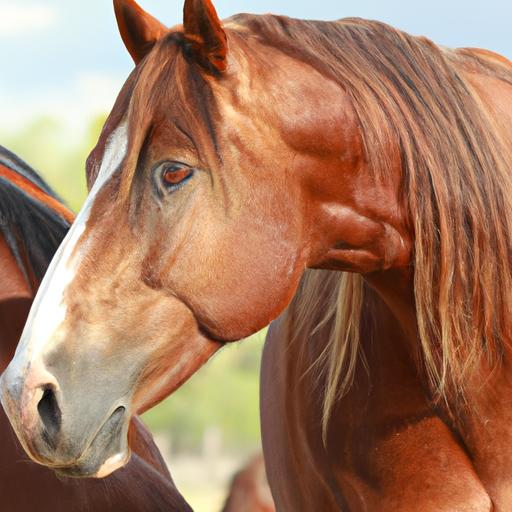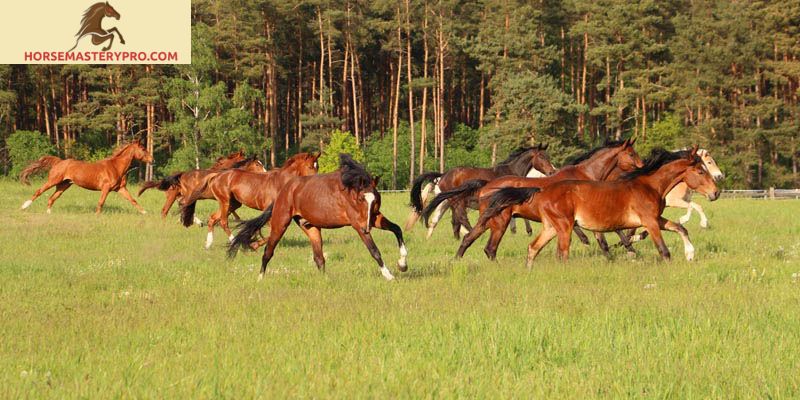Unlock the secrets to successful horse breeding for beginners. Learn about monitoring and caring for pregnant mares and preparing for the foaling process.
Introduction

As a novice breeder, have you ever wondered about the art and science behind horse breeding? If you’ve been captivated by the beauty and grace of horses, you might be eager to delve into the world of horse breeding. But where do you begin? Fear not, for I am here to guide you through the fundamentals of horse breeding for beginners.
Understanding the Basics of Horse Breeding for Beginners
Before embarking on this exciting journey, it’s crucial to grasp the basics of horse breeding. Breeding horses involves carefully selecting suitable stallions and evaluating mare characteristics, focusing on traits such as conformation, temperament, and athleticism. By understanding the essential principles, you’ll be equipped to make informed decisions when it comes to breeding stock.
Importance of Proper Horse Breeding Techniques for Novice Breeders
Proper horse breeding techniques play a pivotal role in ensuring successful outcomes for novice breeders. By implementing the right strategies, you can increase the chances of producing healthy and well-rounded foals. It’s not just about the breeding process itself, but also about the long-term impact on the horse population. Responsible breeding contributes to the preservation and improvement of horse breeds, while avoiding potential genetic issues.
In the next sections, we will explore the intricacies of choosing the right breeding stock and preparing mares for breeding. We’ll also delve into various breeding techniques, the exciting journey of pregnancy and foaling, and the essential post-breeding care for both mare and foal. By the end of this article, you’ll have gained valuable insights into horse breeding, empowering you to embark on this incredible adventure.
Remember, at Horsemasterypro.com, we believe that horse breeding is an art form that requires knowledge, dedication, and a genuine love for these majestic creatures. Let’s dive into the world of horse breeding together!
Choosing the Right Breeding Stock
Breeding horses involves a meticulous selection process to ensure optimal results. Whether you’re considering breeding your own horse or seeking an outside stallion, choosing the right breeding stock is paramount. Let’s dive into the key considerations when selecting stallions and evaluating mare characteristics for successful breeding.
A. Selecting Suitable Stallions for Breeding
When it comes to selecting stallions for breeding, it’s crucial to assess various factors to enhance the chances of producing exceptional offspring. Consider the stallion’s pedigree, performance record, and genetic traits. Are there any notable achievements or bloodlines that can contribute to the desired qualities in the foal? Additionally, evaluate the stallion’s conformation, temperament, and overall health to ensure compatibility with the mare.
Furthermore, consider the stallion’s breeding history. Has he produced offspring with desirable traits in the past? Studying the stallion’s progeny can provide valuable insights into his ability to pass on desired characteristics. By conducting thorough research and seeking advice from experienced breeders, you can make an informed decision when selecting a suitable stallion for breeding.
B. Evaluating Mare Characteristics for Successful Breeding
The evaluation of mare characteristics is equally crucial in the breeding process. Assess the mare’s conformation, temperament, and athletic ability, ensuring compatibility with the chosen stallion. Look for any potential genetic strengths or weaknesses that the mare might possess and consider how they align with the desired traits for the foal.
Additionally, evaluate the mare’s reproductive history and health. Has she had successful pregnancies in the past? It’s important to consider any potential breeding challenges or health issues that may affect her ability to conceive or carry a foal to term. Regular veterinary check-ups and assessments will help ensure the mare is in optimal reproductive health.
Remember, selecting the right breeding stock is a delicate balance between science and intuition. By carefully considering stallion traits and evaluating mare characteristics, you can increase the likelihood of producing foals that possess the desired qualities. Stay tuned as we explore the next steps in horse breeding for beginners, including preparing and managing mares for breeding.
Preparing and Managing Mares for Breeding
Breeding success begins with the proper preparation and management of your mares. Ensuring their optimal health and nutrition is paramount to achieve successful breeding outcomes. Let’s explore two key aspects that require careful attention: maintaining their health and tracking estrus cycles for optimal breeding timing.
Ensuring Optimal Health and Nutrition of Mares
To maximize the chances of a successful breeding, it is crucial to prioritize the health and nutrition of your mares. Providing them with a balanced and nutritious diet is essential for their overall well-being and reproductive health. A diet rich in high-quality forage, supplemented with appropriate minerals and vitamins, will support the mare’s reproductive system and increase the likelihood of conception.
Regular veterinary check-ups are also vital to monitor the mare’s reproductive health. A thorough examination, including ultrasound evaluations, will help detect any underlying health issues that could impact breeding success. Vaccinations, deworming, and dental care should not be overlooked, as they contribute to the overall health of the mare and her ability to carry a healthy foal.
Tracking Estrus Cycles and Optimal Breeding Times
Understanding the estrus cycles of your mares is crucial for optimal breeding timing. Mares typically experience a recurring cycle of estrus, commonly known as “heat,” which occurs every 21 days on average. By closely monitoring their behavior, physical signs, and utilizing veterinary assistance, you can accurately determine when they are receptive to breeding.
There are several methods for tracking estrus cycles, including visual observation, teasing with a stallion, and hormone testing. These techniques help identify the mare’s fertile period, known as the “heat” or “ovulation window.” Timing breeding during this window significantly increases the chances of successful conception.
Remember, each mare is unique, and their estrus cycles may vary slightly. Patience and careful observation are key when tracking their cycles. By prioritizing the health and nutrition of your mares and understanding their estrus cycles, you will be better equipped to optimize breeding timing and increase the likelihood of successful outcomes.
Stay tuned for the upcoming sections, where we will explore different breeding techniques suitable for beginners and delve into the fascinating journey of pregnancy and foaling. At Horsemasterypro.com, we are passionate about providing you with the knowledge and guidance you need to become a successful horse breeder.
Breeding Techniques for Beginners
Breeding horses involves a variety of techniques, each with its own advantages and considerations. As a beginner breeder, it’s essential to familiarize yourself with the different methods available to you. Let’s explore two common breeding techniques that can help you achieve successful outcomes.
A. Natural Cover Breeding Method
The natural cover breeding method involves allowing the stallion and mare to mate naturally. This method mimics the natural breeding process that occurs in the wild. It requires careful management of both the stallion and mare, ensuring they are in optimal physical condition and have appropriate breeding behavior.
When using the natural cover method, it’s important to consider factors such as the mare’s estrus cycle and the stallion’s fertility. By closely monitoring the mare’s heat and allowing them to interact with the stallion at the right time, you can increase the chances of successful breeding. However, it’s crucial to ensure the safety of both the mare and stallion during the breeding process to prevent any injuries.
B. Artificial Insemination Process and Considerations
Artificial insemination (AI) is another popular breeding technique that offers flexibility and convenience. With AI, the semen is collected from the stallion and then introduced into the mare’s reproductive tract. This method allows breeders to overcome geographical limitations and increases the chances of successful breeding with frozen or cooled semen.
When considering AI, it’s important to work with a reputable veterinarian experienced in equine reproductive services. They will guide you through the process, from semen collection and evaluation to insemination timing. It’s crucial to follow proper handling and storage protocols for semen to maintain its viability.
Additionally, AI offers the option of choosing semen from stallions with exceptional genetics, regardless of their location. This widens the pool of potential breeding partners for your mare, allowing you to select the best match for her traits and characteristics.
By understanding the differences between natural cover breeding and artificial insemination, you can choose the method that aligns best with your goals and circumstances. Whether you opt for the traditional approach or embrace the advancements of AI, both techniques have the potential to yield successful breeding outcomes.
In the upcoming sections, we will delve into the journey of pregnancy and foaling, as well as the crucial post-breeding care for both the mare and foal. Stay tuned for more insights into the exciting world of horse breeding for beginners!
Conclusion
Congratulations! You have now gained a solid understanding of horse breeding for beginners. Throughout this article, we have explored the basics of horse breeding, emphasizing the importance of proper techniques for novice breeders like yourself.
Remember, when it comes to horse breeding, knowledge is power. By carefully selecting breeding stock, preparing mares for breeding, utilizing appropriate breeding techniques, and providing proper care during pregnancy and foaling, you can increase the likelihood of producing healthy and successful foals.
At Horsemasterypro.com, we are dedicated to providing valuable resources for horse enthusiasts like you. Our goal is to empower you with the knowledge and skills necessary to embark on this journey with confidence. Whether you aspire to breed horses for pleasure, competition, or preservation of a particular breed, we are here to support you every step of the way.
If you’re ready to take your horse breeding journey to the next level, visit Horsemasterypro.com for additional articles, guides, and resources. Our community of experienced breeders and trainers is ready to share their insights and offer guidance to help you achieve your breeding goals.
Remember, horse breeding is a remarkable endeavor that requires dedication, patience, and a deep appreciation for these magnificent animals. Let your passion for horses guide you as you embark on this fulfilling and rewarding journey.
Thank you for joining us at Horsemasterypro.com. Together, let’s unlock the secrets to successful horse breeding and make a positive impact on the equine world.


